|
|
|
Unfortunately
for Bluebird motorfloater flying, my local airfield has
curtailed all ultralight flying indefinitely.
This means that Bluebird flying has reached an end for the moment since I have no alternative airport or other place at which to fly in a practical way. My goals for the project have been mostly achieved, so it's not a bad time to stop or change course, but I do miss my frequent flying. I hope I have contributed to innovative ultralight flying and hope to see more of it. |
3 May 2022....late afternoon, varying windMainly
this was a flight for fun and practice. I had felt some
peculiar rolling at tree top level that made me want to check
my rudder before flying any more, so I aborted the takeoff and landed
in the grass at the end of the runway. Everything
looked good on the ground. I scooted (I taxied but only while
balanced on the main wheels) downwind on the hard surface
runway, and started the flight over. There may be some
peculiar turbulence coming off the tree line on these windier
days. Later
at high altitude I did some experimental wallowing with the
stick held full back and the engine at cruise rpm. Usually the
nose would drop slightly, but with very smooth operation I was
able to keep the nose up continuously without dropping. In a
moderate turn, when the stick is brought full back, there is
still a mild nose drop, but then instead of dropping the
inside wing (as might be expected) the plane tends to level
out as the nose drops. I don't understand this leveling
tendency but it is not unwelcome. I'm
always looking for Bluebird improvements. I considered moving
the fuel tank higher to avoid fuel line bubbles, but I'm not
going to do it because the height is good now for convenient
re-fueling. Then I was going to lower the tail skid to make
the tail section deeper, allowing the rudder and vertical
stabilizer to be the same size as now but a different shape
and farther back. However, I then realized that the present
shape is just right for raising the tail skid to shoulder
level with the nose skid still clear of the ground, so I can
wheel the plane around easily, so I don't want to change that.
The only change I am looking at right now is to perhaps use
some bouncier wheels, as I had on the Bloop biplanes, to make
the plane more robust in hard landings on rough fields. These
would just be the "fat" BMX bicycle tires and tubes I am using
now (after all, aircraft tires do not come with knobby tread
and stylish gum sidewalls) but with extreme wide rims (4
inch). The wider rims allow a larger internal volume for a
given tire pressure, thus more bounce. |
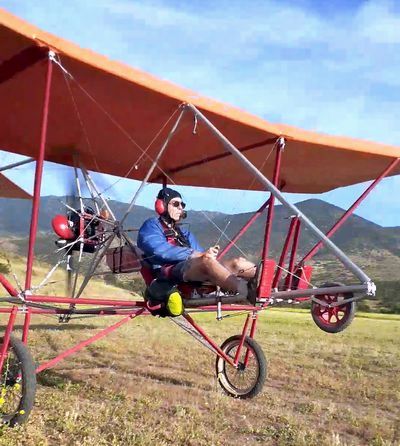 |
26
April 2022....late afternoon, smooth wind
|

|
18 April 2022, late afternoon, smooth winds There above is the day's
photo, showing the Bluebird as it is after more than a year of
flying. There are 30 hours on the engine (recorded and
displayed by the tachometer), so perhaps I flew 45 minutes a
week, except for some intervals of modification and bad
weather. Engine operation has been good, without any reworks
or adjustments, so I'll just keep flying with it until I see a
problem, such as not reaching full speed, abnormal noises, or
something like that. Today I did a touch and go on the paved
runway, then a landing on the dirt (shown above). Both
landings were preceded by a prolonged engine idle, so the
windmilling propeller could drag me down on a steep approach.
I wanted to practice dealing with landings at the full rate of
descent of the approach.
On the first touch down, the flare was ineffective and did not do much to reduce the high descent rate, so I hit hard (I could feel the tires going down on the rims) and bounced a little. This was a good landing, I could have approached over obstacles and then stopped after a minimal ground roll if I had to. Soft landings are for airshows, a serious landing gets the plane down promptly. My landing flare usually reaches full back stick at the very end, a few feet off the ground, but the airspeed can be so low that the plane just keeps sinking fast. The second touch down, on the dirt, seemed softer, I may have dived a little more and had more airspeed. My runway alignment was not very good, I rolled my left wheel right through a big squirrel crater (in the photo above, a couple of meters behind the rudder), but the ground speed was really slow so it was just another big bump. These flights were fun and interesting, so I'll do more like them, but in response to high landing loads I may need to consider bouncier wheels and a strengthened airframe. Other items: my EGT gage has stopped working. It's reading zero all the time, whereas it used to read about 800 deg. F in flight. |
|
5 April 2022.......late
afternoon, some headwind
I don't taxi, I just wheel
the plane around the airport, as you see.
I posted a Youtube video, look for "Bluebird Ultralight Airplane". The flying view needs a little adjustment, so I don't cut the top of my head out of the picture. You can see the new Styrofoam fairings on the wheel struts, still taped in place, unfinished. Also notice the little zipper bag attached onto the back of the seat, it doesn't show in the drawings but it is needed for hats, cameras, maps, tools, water bottles, etc. A day pack would work well here. This is a good view of those stylish, gum wall knobby tires, and that custom retro throttle quadrant. Truly a throwback to the Edwardian era! At the end of the video clip I look like I'm going pretty fast, but that's because I'm going downwind close to the ground. |
|
25 March 2022.......late afternoon, light winds I flew a couple of "touch
and go" patterns for practice. I came down onto my short,
rough field, got the wheels rolling, and throttled up to full
power in order to climb. I wanted clearance for a left turn
over the trees. There is enough room to do this, even without
a headwind, if I start my flight on the ground, but a "touch
and go" starts the takeoff farther down the runway, and that
put me in a tight situation. When I tried to pull the plane
off the grass and get up fast, it just didn't happen. The
plane clung to the ground, floated a couple of feet high in
ground effect, then just climbed at a leisurely rate
regardless of how high I put the nose up.
This sedate flight performance is pretty normal for the Bluebird, but it can be frustrating. When you have intentions and want to climb fast, it's not going to happen, so you have to relax and wait, and maybe make another plan. I notice this mainly on the downwind leg of the landing pattern after a low takeoff, it will only climb so much and may not allow the higher pattern approach I want. |
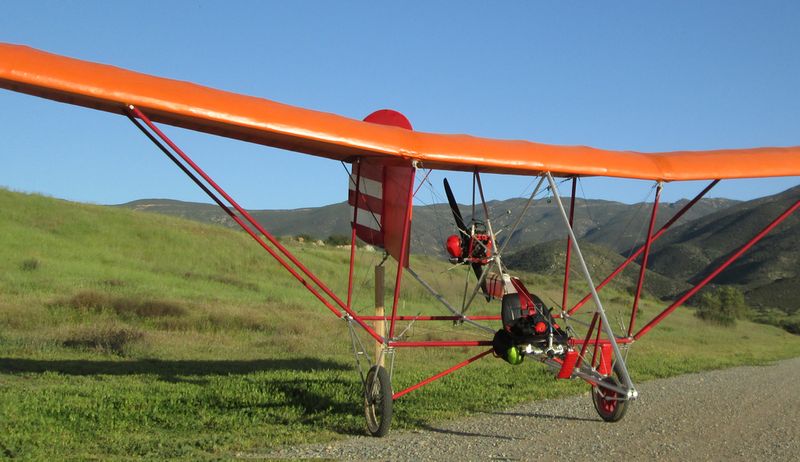 |
18
March 2022....late afternoon, slight winds
|
|
I'm
ducking under cables and climbing into the plane while the
engine warms up. When it's time to go I use full throttle but
the engine lags for a while. At the end I'm making a normal
turn toward the hills.
|
At
landing time I'm making a normal approach to my unpaved runway
under near calm conditions. I take the option of a nose down
stop, demonstrating my ground brake and making it easier to
get out of the plane.
|
14
March 2022....late afternoon, mild winds
|
1
March 2022....late afternoon, slight winds
|
18
February 2022....late afternoon, slight winds
|
13 February
2022....warm & calm
|
|
|
Here's
the takeoff from yesterday's video. At the start I'm standing
out front while the engine warms up, but the engine is at low
power so the plane does not move. I stand in front of the
plane during warm up in case it does start to roll away while
I am not watching, then it will come up and tag me. This might
be another advantage of having the propeller in back. The
engine warm up is specified by the engine maker, usually about
two or three minutes well above idle and including a run up to
full speed. (In the video I edited out the run up, getting in
the plane, and the takeoff radio call. My webpage server
limits upload file size, so if I want to post a video longer
than 30 seconds I will have to use Youtube or Vimeo). |
|
12
January 2022.....late afternoon, increasing and turning winds,
getting darker
|
 |
8 January 2022.....mid day, slight winds, wore a jacketI
made a quick flight, just to get up and around the pattern. I
would have done more except I was low on fuel. My procedures
looked good: landing was reasonably straight ahead, course
equals heading (which is what you get when the cross winds are
very light), and when the wheels touched I pushed the nose
down to level, raising the tail to the the ground roll
"good control" position. I don't recall if I looked at the far
end of the runway as I was planning to, but I felt I had done
my duty and demonstrated good landing practice this time.
|
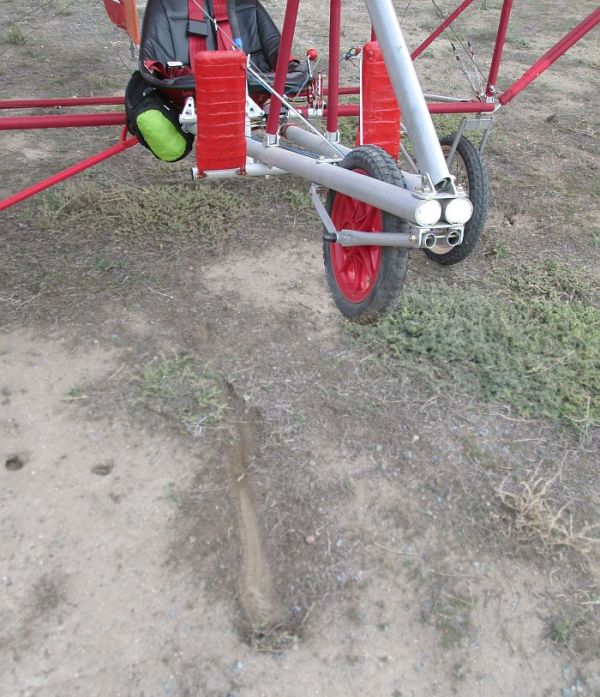 |
21.December.2021...
My after-landing photo today shows the divot in the dirt from my nose wheel stop at the end of the unpaved runway, the result of a normal nose down landing. The non-rotating wheel, actually a nose skid, serves as a ground brake but only acts over a distance of about a meter when used at slow speed. True confession: my nose wheel is junk and needs a re-design (notice the side tilt in the photo, it wobbles). The current setup is brainless, it was derived from the previous system by switching the rear struts to the front and swinging the wheel back into the frame, where it just happened to fit snugly by accident. The old front struts became the rear struts, and now I had a shorter airplane that fit better in the hangar. My main wheels are at the center of lift, so I can stop on the nose or tail, I just have to make up my mind while rolling before I slow down so much that I lose pitch authority. If I wait too long, I can still add power to speed up, and then choose which way to stop, as I did on today's ground roll. If I want to stop on the nose, I hold a forward position on the stick to keep the nose a little low, and when I get slow enough the nose will drop and stop. The nose down stop is probably essential for landing a motorfloater in a very strong wind and getting out of the plane safely. The Bluebird main wheels have no brakes, just as in the early years of airplane flying. I was trying to compare conventional airplane tires to my knobby bicycle wheels, when I realized this was mostly pointless. Modern airplane tires are very much designed for their braking properties on hard runways, which mean little to me. The knobby main wheel BMX tires may become my tires of choice if they can resist punctures by thorns, which the bicycle literature says they do. I have seen some signs of this, I have already removed thorns from the new tires that were not driven as far into the rubber as they often are with the street treads. Maybe I don't need to put sealant slime in the tubes anymore, that would be a benefit. Right now I'm applying blue thread locking compound to all my maillons, the quick links I use for nearly all my lines and cable tensioning. These removable links are very practical for line and cable attachment but they tend to unthread themselves under vibration, which could make them the weak point in the cable. I have locked the maillons before with tape or a strong twist with pliers, but the locking compound should be just a good, maybe more reliable and durable. This thread locker is not much used on aircraft, as far as I know, but I'm willing to try it on hardware that is visible on every pre-flight inspection. Looking
at the video below you might see a lower throttle position
than expected. I'm at fairly high engine speed (cruising
with a very small engine), but the throttle is not advanced
very far forward (forward being the increasing power
direction). This is an example of design legacy, on my
biplanes it was the same, I never bothered to set up the
throttle beyond adequate function, full power is barely
halfway forward on the lever. I have used the same hardware
in the same way on several successive designs, never
bothering to set it up as originally intended. Maybe now
I'll change it so the full throw gives full power. I don't
think this will give me much more precise engine speed
control, nor do I have much need for precise control, but I
might like it.
|
16.December.2021... Today
I accidentally recorded my first Bluebird inflight video, so
here it is, all four seconds of it! I was fumbling around,
trying to take still photos with my digital camera, and this
is what I got. Prepare for a sound blast, this comes
complete with 80cc engine noise at the cruise throttle
setting. (When will there be an electric motor with a big,
slow turning prop that is not loud? We don't have to wait for
better energy storage, the quiet system could be developed
now.)
At right below, above the tire, you see one of my new wheel fork assemblies, to keep the fat BMX tires clear of contact with the front landing gear struts. I flew with them but I need to finish the adjustments and fly in calm conditions to really judge the stability of this setup. These knobby tires may be a mistake if they are less stable than the much smoother street tires. There was a lot of wind effect today. The downwind nudge at liftoff was exactly what I didn't need while trying to evaluate a new wheel setup. All three landing approaches (two were touch and go practice) involved intermittent crosswinds, so I would sometimes be touching down in the middle of a drift correction, one wheel low at a bank angle, a "wheel dance" landing, again not very useful for testing the landing gear.
I'm taking off toward a row of trees at my airport. The
headwind produces a big sink hole in the middle half of my
takeoff leg, but there is usually big lift on the upwind side
to make up for it. This is kind of a test of faith with my
little engine, I sometimes lose all my takeoff climb and have
to wait for a boost to get high enough to cross over the
trees. This is a motorfloater, so if necessary I can just turn
back and circle up to get over an obstacle, but in the takeoff
pattern I prefer not to deviate from what is expected unless I
have to. Today was a good sink and lift day, no
problems.
Turning from upwind to downwind is visually dramatic at low altitude in a slow flying airplane. A steady wind has no actual effect on the flight of the plane, you are turning normally, but you see the ground sliding away to the side as it might in some horrendous side skid. I saw this again today, and I can understand once again why the temptation to react is strong. My airplane's attitude looked normal, so I just sat there and let it turn until the visuals got less extreme. Some later changes from what is shown in the video and photos: the red throttle knob is now black (an aircraft recommended standard for combustion mass flow) and the red tape on the maillons (quick links) is gone, replaced by the use of thread locking compound (not an aircraft standard). |
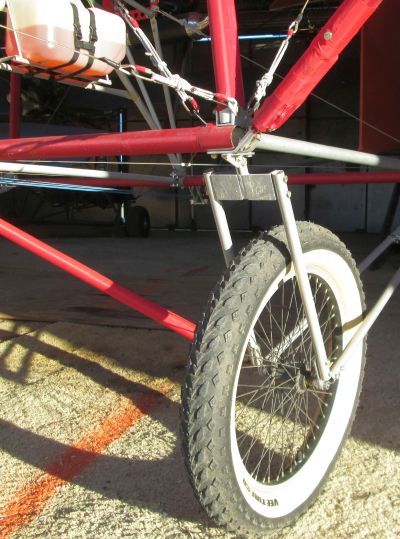 |
12.December.2021.....late afternoon flightFlying
with a small engine is beginning to feel normal. The slow
climb rate has not been a problem, just something to get used
to and allow for. Maybe this is the way it should be, flying
with a minimal
engine to reduce fuel handling, engine influence on flight
control, noise, and landing distance due to weight.
|
|
28.November.2021......just
before sunset
Calm and warm, still flying in shorts and a jacket. Take off was delayed a little while by golf carts and people doing field maintenance, also by paragliders coming over from the local soaring ridge to land on the airport grass (grass is unusual for a California landing). I was amused to note that they mostly acted as if there was no traffic. Even at the runway threshold in the plane with my engine running I am still invisible. In other words, as airfield traffic goes, I count as zero. This is somewhat realistic, since my operations usually are very slow and predictable, taking up very little ground space. However, I waited until the entire field was clear before taking off, because if things had gone wrong I might have needed extra room. I floated around, taking pictures while banked left and right to get a good measurement of my "usual" turning bank angle (wingtip visually on the horizon). The measurement method is similar to looking at the pilot's view photo below where I see the rudder tube at an angle of about 21 degrees to the (poorly defined) horizon, indicating a 21 degree bank. Previously I thought it was turning at about 25 degrees, but now I am measuring 18 degrees. Typically, if I have good altitude and I want to briefly tighten a turn, I just pull the nose up, like an RC model with aileron turn control. In the walk away photo, after landing, the stuff I wear flying is piled in the seat. This is unphotogenic but realistic. Maintenance List: there is still a light intermittent wheel rub against one landing gear strut, that needs adjustment. The flip down cover on the engine run switch is hanging up before the switch is opened (off), needs lubrication. The pitch trim seems a little nose down in flight, I'll tighten the stick bungee (in photo: light colored line from stick bottom forward to nose). In the photo notice that the right rudder pedal is back and the control line is drooping below the tail boom. The bungee cord rudder pedal return needs attention. |
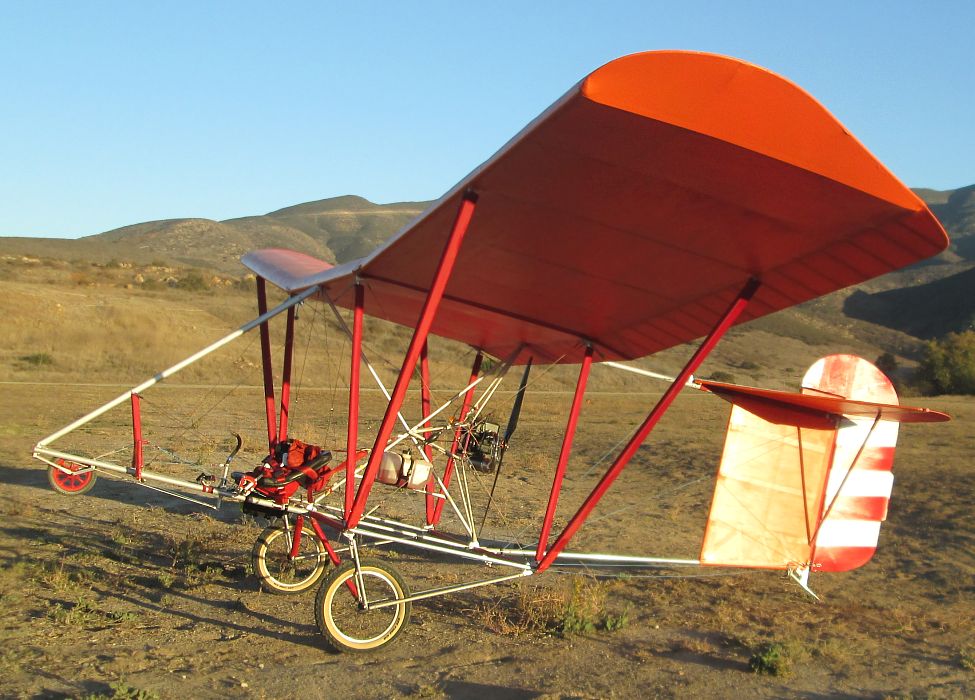 |
 |
15.November.2021...an
hour before sunset Conditions
are still warm and pleasant. I did some continuous turn
and reversal exercises for practice. My comfortable bank for
ordinary turning seems to be about 25 degrees, like the photo.
I set down on the paved runway, the first time on a hard surface with my new wheels. They are soft and bouncy, fun to use and quite satisfactory. Bluebird is suffering right now from classic hangar rash. I banged the rudder into the hangar door frame, and collapsed some of the foam core rib structure. This will be an easy repair, but bothersome because because it will require some fabric and paint work. My cosmetic standards are not high, as you can tell by the finish on the block of Styrofoam glued in place to fill the rudder gap. |
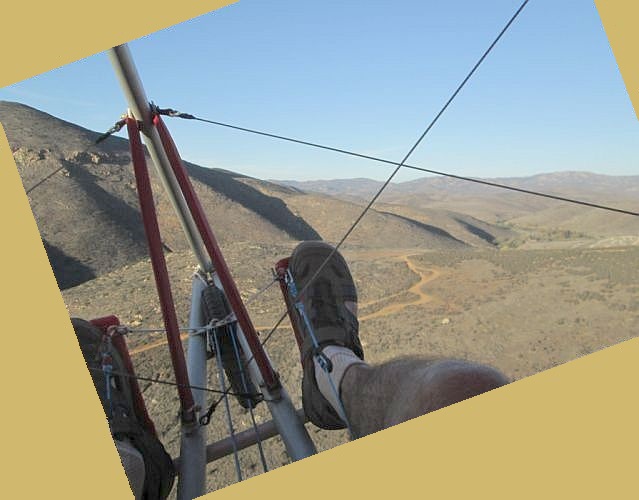 |
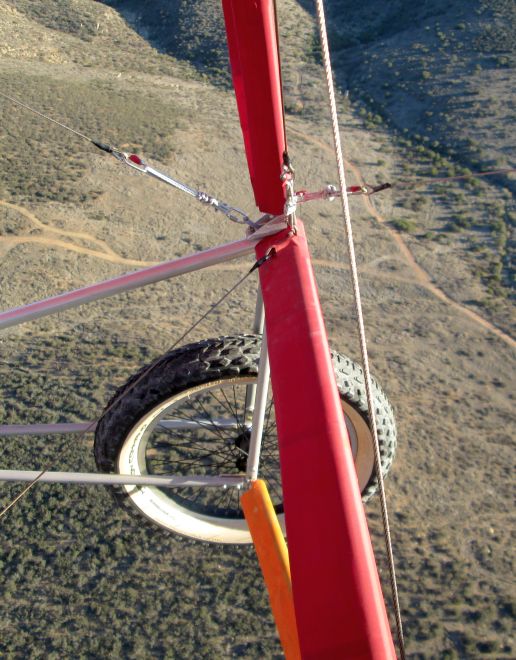
|
12.November.2021....about
an hour before sunset
There's
nothing much to test on this flight, it's just for
fun.
Looking down at my new stylish wheel, I am gaining confidence that it will do its job and let me set down at some side angle while bouncing on through the squirrel holes. I still doubt that the knobby tread is good for anything but show and spurious drag on an airplane, but I suppose there's always room for some nonsense. I haven't tried these tires on the pavement yet. As you can see below, it's still warm enough for shorts and toe sandals. The Pacific Ocean is out there, hidden in the haze. I was satisfied by just poking around the local area. My landing was the most accurate in a while, even though there was no evident headwind to help out, so I was pleased. On the 500 foot dirt runway I try to land as short as possible, pretending that my airfield is small. Actually I have a big over run if I get sloppy and need it. Earlier, while driving to the airport, I had stopped for a little fresh gas. As usual I pumped 0.8 gallons into my mixing jug, with a half charge of oil already in it, which will give me the right fuel/oil mix if the station pump is accurate. I shook it up and poured it into the Bluebird tank, and it's good for the next couple of flights, because I'm not using much fuel. I'm making short flights but with a lot of satisfaction. I'm still self-inflating on my claim of flying the world's most efficient gas powered airplane, a boast so far unchallenged. |
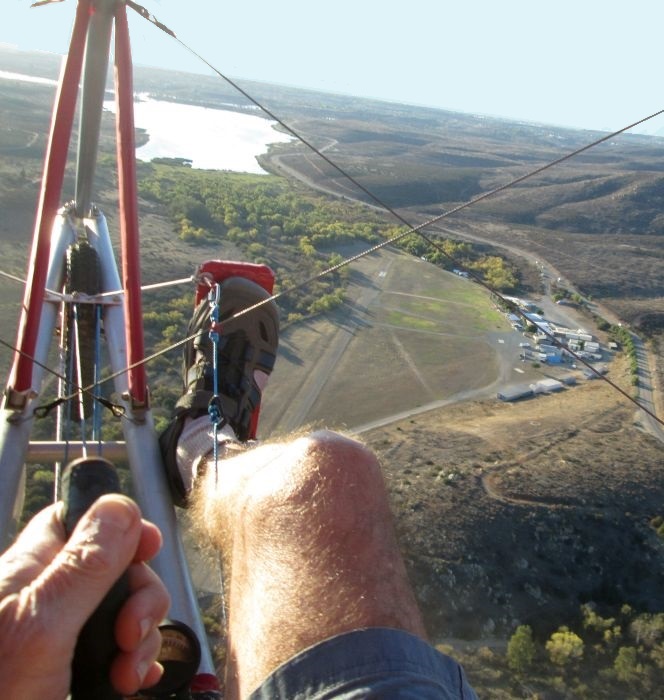
|
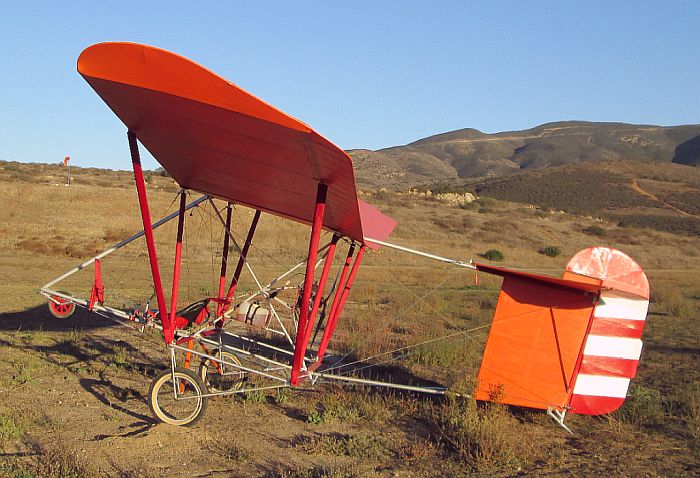 |
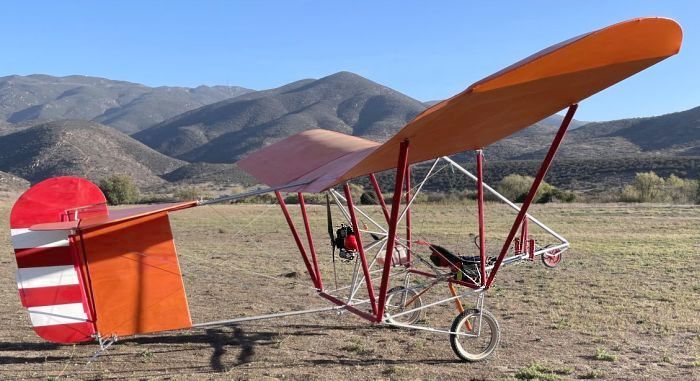 |
9.November.2021
New
tires! I installed larger bicycle tires for a more elastic
landing gear suspension, (and to get the gum colored sidewalls
for a new "retro" look). These tires are BMX 20 x 4 (nominal
20 inch diameter, 4 inches wide) with moderate knobby treads,
still mounted on the nominal 1.75 inch rims (not a real rim
dimension, these wheel rims are sized for a 1.75 inch wide
tire). The previous tires were 3 x 20, so this larger set will
have a greater internal volume of air, even when mounted on
narrow rims. They should be softer and give me
more bounce during hard landings. Flying with these tires was
ordinary, maybe a little softer on touchdown. I'm glad they
didn't pop out of their rims, I'll keep them well inflated as
a precaution. At takeoff the motor took 4 or 5 seconds to come to full power, a real slow response. Maybe this is typical of new engines as they get used. This is usually no problem except when using a short or rough runway, where you might want to get off the ground fast and climb steeply.
|
|---|
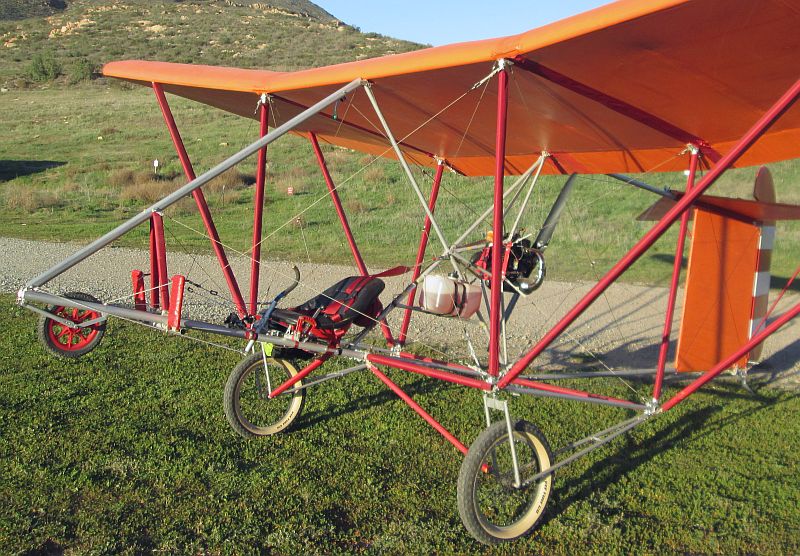 |
24.October.2021....an hour before sunsetAnother sunset flight with mild wind
conditions, cross at about 5 mph. but actually quite
comfortable. I wore hiking shorts and a puffy jacket. Will
this be the last warm flight of the season? Hopefully not.
|
26.August.2021.....morning
flight
|